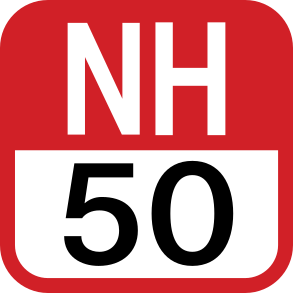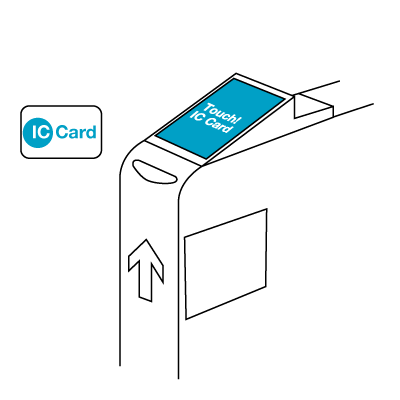|
Meitetsu Ichinomiya Station
220px, Track layout is a railway station in the city of Ichinomiya, Aichi Prefecture, Japan, operated by Meitetsu. Lines Meitetsu-Ichinomiya Station is served by the Meitetsu Nagoya Main Line and is 86.4 kilometers from the starting point of the line at . It is also served by the Meitetsu Bisai Line, and is located 25.3 kilometers from the starting point of that line at . Station layout The station has two elevated island platform, with the station building underneath. The station has automated ticket machines, Manaca automated turnstiles and is staffed. The station is physically joined to JR Central's Owari-Ichinomiya Station. Platforms Adjacent stations Station history The station opened on 24 January 1900 as . It was renamed Meitetsu-Ichinomiya on 29 January 2005. The station was reopened as an elevated station on 21 February 1993. Passenger statistics In fiscal 2016, the station was used by an average of 17,700 passengers daily. Surrounding area *Me ... [...More Info...] [...Related Items...] OR: [Wikipedia] [Google] [Baidu] |
Manaca
Manaca, written in lower-case letters, is a rechargeable contactless smart card used in Nagoya, Japan and the surrounding area since February 11, 2011, when it replaced the Tranpass magnetic fare card system. As of March 23, 2013, it became compatible with 9 other IC cards, allowing it to be used nationwide. Etymology The name comes from the Japanese word , meaning "center", because Nagoya is roughly in the center of Japan, and because it claims to be a central part of your lifestyle. The name, even in Japanese, is written in Roman letters as "manaca", usually with a lowercase "m". Usage Manaca has a feature set similar to other prepaid IC Cards used across the country. It provides a convenient method of payment for train and bus fares while also being accepted as payment at some shops, restaurants, and vending machines. Manaca cards can be purchased from ticket machines located in subway, city bus and Meitetsu bus and train stations, and are available in both registered ... [...More Info...] [...Related Items...] OR: [Wikipedia] [Google] [Baidu] |
Railway Stations In Aichi Prefecture
Rail transport (also known as train transport) is a means of transport that transfers passengers and goods on wheeled vehicles running on rails, which are incorporated in Track (rail transport), tracks. In contrast to road transport, where the vehicles run on a prepared flat surface, rail vehicles (rolling stock) are directionally guided by the tracks on which they run. Tracks usually consist of steel rails, installed on Railroad tie, sleepers (ties) set in track ballast, ballast, on which the rolling stock, usually fitted with metal wheels, moves. Other variations are also possible, such as "slab track", in which the rails are fastened to a concrete foundation resting on a prepared subsurface. Rolling stock in a rail transport system generally encounters lower friction, frictional resistance than rubber-tyred road vehicles, so passenger and freight cars (carriages and wagons) can be coupled into longer trains. The rail transport operations, operation is carried out by a ... [...More Info...] [...Related Items...] OR: [Wikipedia] [Google] [Baidu] |
Railway Stations In Japan Opened In 1900
Rail transport (also known as train transport) is a means of transport that transfers passengers and goods on wheeled vehicles running on rails, which are incorporated in tracks. In contrast to road transport, where the vehicles run on a prepared flat surface, rail vehicles (rolling stock) are directionally guided by the tracks on which they run. Tracks usually consist of steel rails, installed on sleepers (ties) set in ballast, on which the rolling stock, usually fitted with metal wheels, moves. Other variations are also possible, such as "slab track", in which the rails are fastened to a concrete foundation resting on a prepared subsurface. Rolling stock in a rail transport system generally encounters lower frictional resistance than rubber-tyred road vehicles, so passenger and freight cars (carriages and wagons) can be coupled into longer trains. The operation is carried out by a railway company, providing transport between train stations or freight customer facili ... [...More Info...] [...Related Items...] OR: [Wikipedia] [Google] [Baidu] |
Shubun University
270px, Shubun university is a private university in the city of Ichinomiya, Aichi is a city located in Aichi Prefecture, Japan. The city is sometimes called Owarichinomiya to avoid confusion with other municipalities of the same name, including Ichinomiya (now part of the city of Toyokawa), Ichinomiya in Chiba Prefecture. ..., Japan, established in 2008. Undergraduate program Faculty of Health and Nutrition *Department of Nutrition Faculty of Nursing *Department of Nursing External links Official website Educational institutions established in 2008 Private universities and colleges in Japan Universities and colleges in Aichi Prefecture Ichinomiya, Aichi 2008 establishments in Japan {{aichi-university-stub ... [...More Info...] [...Related Items...] OR: [Wikipedia] [Google] [Baidu] |
Japan National Route 155
National Route 155 is a national highway of Japan connecting Tokoname, Aichi and Yatomi, Aichi in Japan, with a total length of . It serves as Nagoya's outer loop. History Route 155 was originally designated on 18 May 1953 from Nagoya to Toyama. This was redesignated as Route 41 in 1959. The current routing of Route 155 dates from 1963. See also * * References 155 Year 155 ( CLV) was a common year starting on Tuesday (link will display the full calendar) of the Julian calendar. At the time, it was known as the Year of the Consulship of Severus and Rufinus (or, less frequently, year 908 ''Ab urbe condita'' ... Ring roads in Japan Roads in Aichi Prefecture {{Japan-road-stub ... [...More Info...] [...Related Items...] OR: [Wikipedia] [Google] [Baidu] |
Masumida Shrine
is a Shinto shrine in the Masumida neighborhood of the city of Ichinomiya in Aichi Prefecture, Japan. It is the ''ichinomiya'' of former Owari Province. The main festival of the shrine is held annually on April 3. Enshrined ''kami'' The ''kami'' enshrined at Masumida Jinja is: * , ''kami'' of the sun and agriculture, the younger brother (or father) of Ninigi, and the ancestor of the Owari clan, the prehistoric rulers of the area. Beppyo shrines History The date of Masumida Shrine's foundation is unknown. Shrine tradition and the '' Kujiki'' records give the unlikely date of 628 BC, or the third day of the third month of the 33rd year in the reign of Emperor Jimmu, when the spirit of Amenohoakari was brought to Owari from the Mount Katsuragi in Yamato Province. Another tradition gives the date of foundation to the reign of the semi-legendary Emperor Suinin (97 BC – 30 BC). The shrine is located near the site of the provincial capital of Owari Province, established in the N ... [...More Info...] [...Related Items...] OR: [Wikipedia] [Google] [Baidu] |
Owari-Ichinomiya Station
270px, Track Layout is a railway station in the city of Ichinomiya, Aichi Prefecture, Japan, operated by Central Japan Railway Company (JR Tōkai). The station is physically joined to Meitetsu-Ichinomiya Station. Lines Owari-Ichinomiya Station is served by the Tōkaidō Main Line, and is located 383.1 kilometers from the starting point of the line at Tokyo Station. Station layout The station has two elevated island platforms with passing loops with the station building underneath. The station building has automated ticket machines, TOICA automated turnstiles and is staffed. Platforms Adjacent stations Station history The station opened on 1 May 1886 as . It was renamed to on January 1, 1916, with the spelling changed to its present form on November 15, 1952. Freight operations were discontinued in 1979. With the dissolution and privatization of the JNR on April 1, 1987, the station came under the control of the Central Japan Railway Company. A new sta ... [...More Info...] [...Related Items...] OR: [Wikipedia] [Google] [Baidu] |
JR Central
is the main railway company operating in the Chūbu (Nagoya) region of central Japan. It is officially abbreviated in English as JR Central and in Japanese as JR Tōkai ( ja, JR東海, links=no). ''Tōkai'' is a reference to the geographical region in which the company chiefly operates. JR Central's operational hub is Nagoya Station and the company's administrative headquarters are located in the JR Central Towers above the station. The busiest and longest railway line operated by JR Central is the Tōkaidō Main Line between and . The company also operates the Tōkaidō Shinkansen between and . Additionally it is responsible for the Chūō Shinkansen—a maglev service between Tokyo and Osaka, which is due to start operation between Tokyo and Nagoya in 2027. JR Central is Japan's most profitable and highest throughput high-speed-rail operator, carrying 138 million high-speed-rail passengers in 2009, considerably more than the world's largest airline. Japan recorded a ... [...More Info...] [...Related Items...] OR: [Wikipedia] [Google] [Baidu] |
Turnstile
A turnstile (also called a turnpike, gateline, baffle gate, automated gate, turn gate in some regions) is a form of gate which allows one person to pass at a time. A turnstile can be configured to enforce one-way human traffic. In addition, a turnstile can restrict passage only to people who insert a coin, ticket, pass, or other method of payment. Modern turnstiles incorporate biometrics, including retina scanning, fingerprints, and other individual human characteristics which can be scanned. Thus a turnstile can be used in the case of paid access (sometimes called a faregate or ticket barrier when used for this purpose), for example to access public transport, a pay toilet, or to restrict access to authorized people, for example in the lobby of an office building. History Turnstiles were originally used, like other forms of stile, to allow human beings to pass while keeping sheep or other livestock penned in. The use of turnstiles in most modern applications has been cr ... [...More Info...] [...Related Items...] OR: [Wikipedia] [Google] [Baidu] |
Ticket Machine
A ticket machine, also known as a ticket vending machine (TVM), is a vending machine that produces paper or electronic tickets, or recharges a stored-value card or smart card or the user's mobile wallet, typically on a smartphone. For instance, ticket machines dispense train tickets at railway stations, transit tickets at metro stations and tram tickets at some tram stops and in some trams. Token machines may dispense the ticket in the form of a token which has the same function as a paper or electronic ticket. The typical transaction consists of a user using the display interface to select the type and quantity of tickets and then choosing a payment method of either cash, credit/ debit card or smartcard. The ticket(s) are then printed on paper and dispensed to the user, or loaded onto the user's smartcard or smartphone. Ticket and fare formats For most of the twentieth century, ticket machines issued paper tickets, or tokens worth one fare each. Later, fare value ... [...More Info...] [...Related Items...] OR: [Wikipedia] [Google] [Baidu] |





